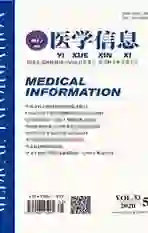CT23基因在脑肿瘤中的表达情况及临床价值
2020-05-11郑葆龙肖绍文
郑葆龙 肖绍文

摘要:目的 检测和明确癌-睾丸相关抗原(CTA)CT23基因在人脑肿瘤中的表达情况,评估该基因潜在的临床价值。方法 收集广西医科大学第一附属医院神经外科14例颅脑肿瘤病理标本,包括星形细胞瘤5例,髓母细胞瘤4例,胶质母细胞瘤5例,使用RT-PCR技术检测CT23基因在不同病理类型的脑肿瘤中的表达情况,比较其在不同类型脑肿瘤中的表达差异。结果 14例脑肿瘤样本中13例CT23表达阳性,其中星形细胞瘤4例,胶质母细胞瘤5例,髓母细胞瘤4例,CT23基因在三类脑肿瘤样本中的表达比较,差异无统计学意义(P>0.05)。结论 CT23基因作为一种肿瘤相关的基因,可表达于多种类型的人类脑肿瘤中,另外该基因的表达与脑肿瘤的发生、发展可能有关。
关键词:CT23基因;脑肿瘤;癌-睾丸抗原;逆转录聚合酶链反应
中图分类号:R739.4 文献标识码:A DOI:10.3969/j.issn.1006-1959.2020.05.028
文章编号:1006-1959(2020)05-0094-03
Abstract:Objective To detect and clarify the expression of the cancer-testis-associated antigen (CTA) CT23 gene in human brain tumors, and to evaluate its potential clinical value. Methods Collected 14 cases of craniocerebral tumor pathological specimens from Neurosurgery Department of the First Affiliated Hospital of Guangxi Medical University, including 5 cases of astrocytoma, 4 cases of medulloblastoma, and 5 cases of glioblastoma. RT-PCR was used to detect the expression of CT23 gene in brain tumors of different pathological types, and to compare the expression difference of CT23 gene in different types of brain tumors.Results The CT23 gene expression was positive in 13 of 14 brain tumor samples, including 4 astrocytomas, 5 glioblastomas, and 4 medullary tumors. Comparison of CT23 gene expression in three types of brain tumor samples, the difference was not statistically significant (P>0.05).Conclusion As a tumor-related gene, CT23 gene can be expressed in many types of human brain tumors. In addition, the expression of this gene may be related to the occurrence and development of brain tumors.
Key words:CT23 gene;Brain tumor;Cancer-testis antigen;Reverse transcription polymerase chain reaction
脑肿瘤(brain tumor)具有治疗难度大,致死率高的特点,我国脑肿瘤发病率呈现出逐年增加的趋势,严重影响了人民的健康。脑胶质瘤是最常见的成人恶性脑肿瘤,约占颅内肿瘤的17%[1],发病率约为3/10万[2],具有恶性肿瘤的典型生物学特性,呈浸润性生长,肿瘤与周围正常脑组织边界不清[3]。有研究利用基因表达系统分析(SAGE)方法从人类睾丸cDNA文库中发现了CT23基因,该基因位于人类第12号染色体短臂1区2带到1区3带之间(12p12~13),全长1933 bp,共10个外显子,可以编码543个氨基酸,特异性地定位于几种物种的生殖细胞的顶体中,包括小鼠、猪、豚鼠和人[4]。CT23基因表達的相关抗原,在睾丸生精小管和人类众多肿瘤组织中广泛存在,如乳腺癌、卵巢癌、结肠直肠癌、骨髓瘤、前列腺癌、肝癌等[5-9]。研究表明[10]该抗原在精子中参与了获能和顶体反应,而在其他正常组织中却几乎不表达,根据该基因的这一特性,本研究认为其有望成为用于判断肿瘤类型和肿瘤免疫治疗的理想靶分子[11]。因此,本实验通过探究CT23基因在多种类型的脑肿瘤中的表达,旨在为未来该基因的研究奠定理论和实验基础。
1材料与方法
1.1样本来源 收集广西医科大学第一附属医院神经外科脑肿瘤样本14例,包括星形细胞瘤5例,髓母细胞瘤4例,胶质母细胞瘤5例。所有样本均经过病理学检查,已通过广西医科大学第一附属医院伦理委员会审查和授权,相关操作符合世界医学协会赫尔辛基宣言关于人体医学研究的伦理准则。所有新鲜肿瘤组织取自肿瘤切除后10 min内立即用冻存管进行分装和标记,然后放入液氮罐速冻,及时用液氮保温瓶带回实验室,放置于-80℃冰箱保存备用。
1.2设备及耗材 超低温冰箱(青岛海尔)超微量分光光度计(北京天根公司)电子天平PB602-N(上海精密科学仪器有限公司)低压电泳仪(Bio-Rad公司)微量移液器(德国Eppendorf公司)普通PCR仪(德国Eppendorf公司)紫外线凝胶电泳成像分析系统(天能UV2000)电泳槽DYCP-31BM(六一仪器厂)台式冷冻离心机(德国Eppendrof公司)离心管及PCR管(Axygen公司)。引物组织总RNA 提取试剂盒(Sangon公司),逆转录试剂盒,PCR反应试剂盒(南京诺唯赞公司),溴化乙锭(Sigma公司)。
1.3除RNA酶 提取总RNA及逆转录过程中,除已标明为Rnase-free的实验用品之外,其他塑料制品(如:EP管、离心管、移液器枪头等)均需要进行除RNA酶处理后方可使用。佩戴一次性口罩,一次性乳胶手套或PE手套,严格按照具体操作规范进行,防止RNA酶污染导致的RNA提取失败。
1.4提取总RNA 取冰冻肿瘤组织(-80℃),天平秤取50 mg置于10 ml离心管中,再加入500 μl Buffer RL1(已加入β-巯基乙醇),离心管外加冰盒,用高速电动匀浆器间断高速匀浆1~2 min,将组织彻底研磨均匀,匀浆后震荡2 min,室温静置备用。根据组织总RNA提取试剂盒(诺唯赞公司)说明书的有关步骤继续进行相应的提取工作。提取完成的总RNA样品,均进过超微量分光光度计的检测和琼脂糖凝胶电泳的检测,对符合要求的总RNA样品直接进行逆转录反应。
1.5 cDNA合成 CT23基因的特异性引物序列为:5-AAGGACAGGGGACTAAGGAG-3(上游引物),5-CCGTACAAATCCAGCCCGTA-3(下游引物)[12]。取2 μg总RNA,依据逆转录试剂盒的相关步骤进行RNA的逆转录,cDNA的质量用人类管家基因GAPDH进行检测和判断,GAPDH基因的引物序列和相关的PCR反应条件均来源于文献[13]。
1.6 RT-PCR反应 采用能够特异性扩增CT23基因的引物进行PCR反应,反应条件如下:预变性(94℃、5 min)、变性(94℃、1 min)、退火(59℃、1 min)、延伸(72℃、2 min)、循环数(35)、彻底延伸(72℃、8 min)。所有相关的扩增反应均采用已经过确认的阳性细胞株样本作为阳性对照,用双蒸水代替组织样本的cDNA作为阴性对照,反应结束后立即进行浓度为2%的琼脂糖凝胶电泳100 V、30 min,然后进行凝胶成像并记录相应结果。
1.7统计学分析 实验数据采用SPSS 20.0软件统计分析,计数资料采用(n,%)表示,采用确切概率法或四格表?字2检验;当P<0.05时表示差异有统计学意义。
2结果
CT23的表达情况:CT23相应引物可特异性扩增出大小约600 bp的基因片段,根据相关文献报道,该片段来源于CT23基因,14例脑肿瘤样本中CT23阳性表达13例,基因阳性率约为92.86%(13/14),其中星形细胞瘤80.00%(4/5),胶质母细胞瘤100.00%(5/5),髓母细胞瘤100.00%(4/4),CT23基因在三类脑肿瘤样本中的表达比较,差异无统计学意义(P>0.05)。CT23基因表达凝胶成像见图1。
3讨论
近年来,肿瘤-睾丸抗原(cancer-testis antigen,CTA)家族受到越来越多的科研工作者的关注,CT23作为该家族的一员,也已经开展了一系列的研究。目前有关该基因的研究主要集中于以下几个方面:①基因表达及表达机制的研究:多个研究报道CT23基因在多种肿瘤中表达,本实验结果也证实了CT23可在多种脑肿瘤中表达。②功能方面的研究:通过siRNA 在体外干扰CT23基因的表达,可明显地减低降低细胞周期调控蛋白cyclin E,迁移/侵袭调节蛋白MMP2和MMP9的表达,有研究发现在体外下调CT23基因的表达可导致胶质瘤细胞和肝癌细胞的恶性生物学行为减弱[14,15]以及骨髓间充质干细胞的生长周期停滞和迁移能力的减弱[16],也可通过促进有丝分裂过程中的纺锤丝的形成,来增加肿瘤细胞的迁移能力[4]。③CT23与免疫调节机制的关系:该基因在结直肠癌患者体内的表达可以引起患者的体液免疫應答[17],其中CT23抗原肽的表达可被CD8特异性识别[18]。
现在已知的抗体类标记物大多来源于肿瘤相关抗原(tumor-associated antigen,TAA),肿瘤组织表达的特异性蛋白能诱导机体产生非特异性免疫反应和特异性免疫反应,如细胞免疫反应和体液免疫反应[19]。已经开展的有关癌-睾丸抗原的疫苗研究显示出对患者预后的积极作用,因此CTA有望成为未来治疗恶性脑肿瘤的潜在靶抗原(carcinoembryonic antigen,CEA),尤其是在一些肿瘤患者的体液或血液中已经检测到肿瘤相关抗体[20,21],说明其在肿瘤早期诊断过程具有重要的辅助作用,具有很大研究潜力。
根据2016年世界卫生组织公布的2007中枢神经系统肿瘤分类第四版修订版的最新分类标准,胶质瘤的来源是神经祖细胞,其中有IDH基因突变的为有IDH突变的神经胶质瘤;没有IDH基因突变的胶质瘤为IDH野生型星形细胞瘤。而髓母细胞瘤不属于胶质瘤,已被划分到胚胎性肿瘤,这进一步加强了有关原癌基因激活和相关致癌作用的机理研究。在临床工作中,通过对癌基因的激活与变异的检测,确定肿瘤的相关病理分类,明确能够直接导致肿瘤细胞凋亡或者直接引起肿瘤事件发生的相关基因是肿瘤分类的基础和前提。自Ono T 等[12]报道了人类 CT23基因以来,国内外对CT23与肿瘤间的联系进行了较多的研究,如卵巢癌、大肠癌、乳腺癌、肝癌等,并预测 CT23基因在肿瘤组织中的表达可能与临床资料存在相关性。本实验通过检测CT23基因在人类脑肿瘤中的表达情况,发现其具有较高的表达频率,说明该基因具有成为靶向治疗的靶点的潜力。
總之,本研究证实了CT23基因可表达于多种类型的人类脑肿瘤中,在未来的研究工作中,拟通过增加样本量,在现有研究结果的基础上,获得更加准确的结论。同时,通过扩大研究方法,如高通量测序技术、免疫组化及基因敲除等相关技术手段,对CT23基因进行更深入的研究。
参考文献:
[1]Smith JS,Chang EF,Lamborn KR,et al.Role of extent of resection in the long-term outcome of low-grade hemispheric gliomas[J].Journal of Clinical Oncology,2008,26(8):1338-1345.
[2]Randomized Trial on the efficacy of Radiotherapy for Cerebral Low-Grade Glioma in the Adult:European Organization for Research and Treatment of Cancer Study 22845 with the Medical Research Council Study BR04:An Interim Analysis[J].International Journal of Radiation Oncology Biology Physics,2002,52(2):316-324.
[3]Popova SN,Bergqvist M,Dimberg A,et al.Subtyping of gliomas of various WHO grades by the application of immunohistochemistry[J].Histopathology,2014,64(3):365-379.
[4]Whitehurst AW.Tumor antigen acrosin binding protein normalizes mitotic spindle function to promote cancer cell proliferation[J].Cancer Research,2010,70(19):7652-7661.
[5]Fan R,Huang W,Luo B,et al.Cancer testis antigen OY-TES-1:analysis of protein expression in ovarian cancer with tissue microarrays[J].European Journal of Gynaecological Oncology,2015,36(3):298-303.
[6]Luo B,Yun X,Fan R,et al.Cancer testis antigen OY-TES-1 expression and serum immunogenicity in colorectal cancer:its relationship to clinicopathological parameters[J].International Journal of Clinical&Experimental Pathology,2013,6(12):2835-2845.
[7]Hu Q,Fu J,Luo B,et al.OY-TES-1 may regulate the malignant behavior of liver cancer via NANOG, CD9,CCND2 and CDCA3:A bioinformatic analysis combine with RNAi and oligonucleotide microarray[J].Oncology Reports,2015,33(4):1965-1975.
[8]Tammela J,Uenaka A,Ono T,et al.OY-TES-1 expression and serum immunoreactivity in epithelial ovarian cancer[J].International Journal of Oncology,2006,29(4):903-910.
[9]Li X,Yan J,Fan R,et al.Serum immunoreactivity of cancer/testis antigen OY-TES-1 and its tissues expression in glioma[J].Oncology Letters,2017,13(5):3080-3086..
[10]Dube C.The Proacrosin Binding Protein,sp32,Is Tyrosine Phosphorylated During Capacitation of Pig Sperm[J].Journal of Andrology,2005,26(4):519-528.
[11]Fagerberg L,Hallstr?m BM,Oksvold P,et al.Analysis of the Human Tissue-specific Expression by Genome-wide Integration of Transcriptomics and Antibody-based Proteomics[J].Molecular&Cellular Proteomics,2014,13(2):397-406.
[12]Ono T,Kurashige T,Harada N,et al.Identification of proacrosin binding protein sp32 precursor as a human cancer/testis antigen[J].Proceedings of the National Academy of Sciences,2001,98(6):3282-3287.
[13]谢学成,邱海,汤帆,等.端粒酶逆转录酶在结直肠癌组织中的表达及其临床意义[J].中国癌症防治杂志,2014,6(3):252-257.
[14]Luo Y,Liang F,Zhang ZY.PRL1 Promotes Cell Migration and Invasion by Increasing MMP2 and MMP9 Expression through Src and ERK1/2 Pathways\r[J].Biochemistry,2009,48(8):1838-1846.
[15]Fu J,Luo B,Guo W,et al.Down-regulation of cancer/testis antigen OY-TES-1 attenuates malignant behaviors of hepatocellular carcinoma cells in vitro[J].International Journal of Clinical&Experimental Pathology,2015,8(7):7786.
[16]Cen YH,Guo WW,Luo B,et al.Knockdown of OY-TES-1 by RNAi causes cell cycle arrest and migration decrease in bone marrow-derived mesenchymal stem cells[J].Cell Biology International,2012,36(10):917-922.
[17]Groff JL,Rutkowski RB,Brantley NB.Automation of a kinetic method for determiningangiotensin-converting enzyme in serum[J].Clinical Chemistry,1995,41(11):1662-1663.
[18]Okumura H,Noguchi Y,Uenaka A,et al.Identification of an HLA-A24-Restricted OY-TES-1 Epitope Recognized by Cytotoxic T-Cells[J].Microbiology and Immunology,2005,49(11):1009-1016.
[19]Karen SA,Joshua L.The Sentinel Within:Exploiting the Immune System for Cancer Biomarkers[J].Journal of Proteome Research,2005(4):1123-1133.
[20]He SJ,Gu YY,Yu L,et al.High expression and frequently humoral immune response of melanoma-associated antigen D4 in glioma[J].International Journal of Clinical and Experimental Pathology,2014,7(5):2350-2360.
[21]Laidi F,Bouziane A,Errachid A,et al.Usefulness of Salivary and Serum Auto-antibodies Against Tumor Biomarkers HER2 and MUC1 in Breast Cancer Screening[J].Asian Pacific Journal of Cancer Prevention,2016,17(1):335-339.
收稿日期:2019-12-09;修回日期:2019-12-19
編辑/成森
